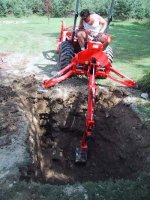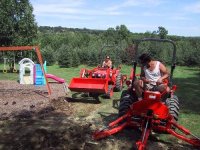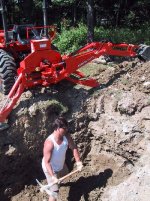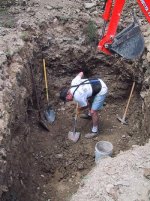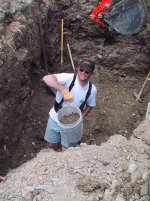PaulT
Gold Member
OK, so I'm late in posting my first 'bota backhoe project. Better late than never! I'm doing this from my sister-in-law's house, so I'll post some pix when I get home later. In the mean time, here's the first installment of the story for those interested.
The beginning:
We bought our house several years ago for a bargain price - what a view we got. We also got a well that failed its flow test, but the owners had a family situation just like ours and they assured us with careful use it would be fine. They were mostly right.
Now my son is 5 and he wants to play in the sprinkler toys he sees on TV. No, I tell him, we can't afford that kind of water usage/w3tcompact/icons/frown.gif Also, one shower and one load of laundry and we're done for at least an hour. And when we have guests, it seems I always end up smelly that day/w3tcompact/icons/blush.gif
Well, this project was one of the motivators to get the wife to agree to the 2710 and backhoe.
The well:
The well pumps about 50-80 gallons at a time, depending on the time of year and recent rainfall. After that, it recharges at about 1/2 gal per minute.
The Bill of materials:
Franklin electric Pumptec(* see footnote) - $99
Norwesco 1200 gallon HDPT Potable water underground cistern - $750 (hauled home in my pickup from 60 miles away)
1/2 HP shallow well jet pump from Lowes - $130
Miscellaneous plastic pipe and fittings to tap the well line into the cistern - about $30
Brass check valve -$12
Brass foot valve - $16
3 Bulkhead fittings to seal the holes cut in the tank - $60
"Pump up" inline float switch w/ counterweight - $30
9 yards of pea gravel - $110
Various galvanized NPT pipe fittings - $15
2 New pressure switches - $35
New pressure gauge - $5
Pipe dope, PVC glue, teflon tape, food grade silicon - $20
8 Stainless Steel screws - $4
Beer and food for the crew - $50
Diesel - $20
Total - $1386
The schedule:
Friday night - get the second 'bota there from about 8 miles away - no trailer yet.
Saturday - DIG, DIG, DIG!
Sunday - Armstrong digging, Place the tank, measure the fitting needs, double check all decisions BEFORE I cut the water line. Tap the cistern into the water line.
Monday - Wednesday evenings - back fill tank and gravel at the same time
Thursday evening/night - install jet pump, remove in-tank bypass and start drawing water from the cistern!
One evening 3 weeks later - replace the old pressure switch and gauge.
Celebrate!
Total time about 80 hours. I probably did 40 hours myself, with my 3 man "crew" putting in about 40 over the first weekend.
The story:
First I had to dig the hole (preferably somewhere near the existing water line/w3tcompact/icons/crazy.gif). The specs on the tank say that the top of it must be buried between 8 and 32 inches below the surface. The tank is 60 inches high, and it must sit on 6-12 inches of compacted pea gravel. That meant the minimum depth of the hole had to be 74 inches. I have a 4672 hoe, so I knew I would need to use my excavator - the Armstrong Universal Pick and Shovel/w3tcompact/icons/frown.gif Also, the ground slopes some, so we would need to be deeper on the high side by about 6 more inches. Thats a lot of digging in northeast clay/rock hardpan. We almost broke the Armstrong several times/w3tcompact/icons/tongue.gif, but found that lubrication and fuel replenishment on a frequent basis helped considerably - (bbq beef, gatorade and the occasional Molson)/w3tcompact/icons/cool.gif
With the side and end clearances added in, I calculated the hole to be around 19cu yds. The tank was 8 yards, and the gravel fill was 9. That amount of dirt needs to be removed as you dig, or you will shortly find yourself boxed in. My buddy brough his 'bota over (another 2710) and he moved the piles with his FEL as I created them with my hoe. Since I was at the limits of the hoe, HOW I dug the hole was also very important, otherwise I might end up with large chunks of dirt that I could not get at (no place to park the tractor). At one point someone commented on the two tractors and said, "Oh, you've got a $45000 hole here!" All of this digging took place on Saturday and Sunday morning.
Gotta go now. I'll post part two and those pix later tonight.
(* This detects when the well pump runs dry via amp draw on the line and shuts it off. It will reset after your choice of 2,5,10,30,45 or 90 minutes. If the well is still dry after the preset interval, it shuts it off, and the timer starts over. I should've installed it years ago)
PaulT
The beginning:
We bought our house several years ago for a bargain price - what a view we got. We also got a well that failed its flow test, but the owners had a family situation just like ours and they assured us with careful use it would be fine. They were mostly right.
Now my son is 5 and he wants to play in the sprinkler toys he sees on TV. No, I tell him, we can't afford that kind of water usage/w3tcompact/icons/frown.gif Also, one shower and one load of laundry and we're done for at least an hour. And when we have guests, it seems I always end up smelly that day/w3tcompact/icons/blush.gif
Well, this project was one of the motivators to get the wife to agree to the 2710 and backhoe.
The well:
The well pumps about 50-80 gallons at a time, depending on the time of year and recent rainfall. After that, it recharges at about 1/2 gal per minute.
The Bill of materials:
Franklin electric Pumptec(* see footnote) - $99
Norwesco 1200 gallon HDPT Potable water underground cistern - $750 (hauled home in my pickup from 60 miles away)
1/2 HP shallow well jet pump from Lowes - $130
Miscellaneous plastic pipe and fittings to tap the well line into the cistern - about $30
Brass check valve -$12
Brass foot valve - $16
3 Bulkhead fittings to seal the holes cut in the tank - $60
"Pump up" inline float switch w/ counterweight - $30
9 yards of pea gravel - $110
Various galvanized NPT pipe fittings - $15
2 New pressure switches - $35
New pressure gauge - $5
Pipe dope, PVC glue, teflon tape, food grade silicon - $20
8 Stainless Steel screws - $4
Beer and food for the crew - $50
Diesel - $20
Total - $1386
The schedule:
Friday night - get the second 'bota there from about 8 miles away - no trailer yet.
Saturday - DIG, DIG, DIG!
Sunday - Armstrong digging, Place the tank, measure the fitting needs, double check all decisions BEFORE I cut the water line. Tap the cistern into the water line.
Monday - Wednesday evenings - back fill tank and gravel at the same time
Thursday evening/night - install jet pump, remove in-tank bypass and start drawing water from the cistern!
One evening 3 weeks later - replace the old pressure switch and gauge.
Celebrate!
Total time about 80 hours. I probably did 40 hours myself, with my 3 man "crew" putting in about 40 over the first weekend.
The story:
First I had to dig the hole (preferably somewhere near the existing water line/w3tcompact/icons/crazy.gif). The specs on the tank say that the top of it must be buried between 8 and 32 inches below the surface. The tank is 60 inches high, and it must sit on 6-12 inches of compacted pea gravel. That meant the minimum depth of the hole had to be 74 inches. I have a 4672 hoe, so I knew I would need to use my excavator - the Armstrong Universal Pick and Shovel/w3tcompact/icons/frown.gif Also, the ground slopes some, so we would need to be deeper on the high side by about 6 more inches. Thats a lot of digging in northeast clay/rock hardpan. We almost broke the Armstrong several times/w3tcompact/icons/tongue.gif, but found that lubrication and fuel replenishment on a frequent basis helped considerably - (bbq beef, gatorade and the occasional Molson)/w3tcompact/icons/cool.gif
With the side and end clearances added in, I calculated the hole to be around 19cu yds. The tank was 8 yards, and the gravel fill was 9. That amount of dirt needs to be removed as you dig, or you will shortly find yourself boxed in. My buddy brough his 'bota over (another 2710) and he moved the piles with his FEL as I created them with my hoe. Since I was at the limits of the hoe, HOW I dug the hole was also very important, otherwise I might end up with large chunks of dirt that I could not get at (no place to park the tractor). At one point someone commented on the two tractors and said, "Oh, you've got a $45000 hole here!" All of this digging took place on Saturday and Sunday morning.
Gotta go now. I'll post part two and those pix later tonight.
(* This detects when the well pump runs dry via amp draw on the line and shuts it off. It will reset after your choice of 2,5,10,30,45 or 90 minutes. If the well is still dry after the preset interval, it shuts it off, and the timer starts over. I should've installed it years ago)
PaulT

